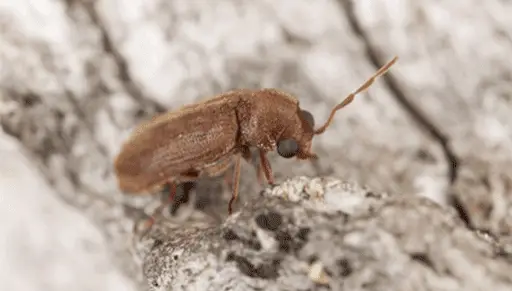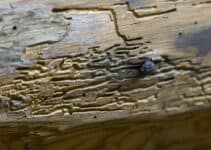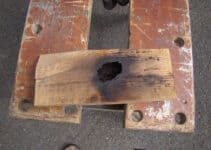If you’re concerned about woodworms spreading around your home, you might have wondered, can woodworm fly? Woodworm can fly, but it’s not as common as you might think. Generally, once they’ve found a piece of wood to live in, they’ll stay there. In fact, it’s fairly common for woodworms to never fly during their lifetimes; they prefer crawling instead.
In this article, we’ll look in more detail about flying woodworms and when you can expect it to happen (if ever).
Can Adult Woodworm Fly?
Adult woodworm can fly, although it’s rare that they do. Unsurprisingly, the larvae can’t fly because, well, they don’t have wings.
As we explain in more detail elsewhere, woodworm typically spread by tunnelling through wood. Adult woodworm will crawl more often than not; they find cracks in wood to lay their eggs and often won’t need to fly.

The important thing to note here is that woodworms have an adult lifespan of around 3 weeks. It’s just long enough to find a mate and produce eggs.
This is basically all their adult life is for, as they spend a much longer period of their existence as larvae. As you might already know, it’s in this stage that they cause the most damage.
You’re most likely to see adult woodworm flying during mating season, which is around May and August depending on weather conditions. They’re focused on finding mates, and in some situations, this might mean having to travel farther.
However, if you’ve got a decent woodworm infestation in your home, they’ll probably find a mate through crawling alone.
Does Woodworm Have Wings?
It’ll probably come as no surprise, but in order to fly, woodworm must have wings. You might be wondering, by extension, how worms have wings.
Woodworms aren’t actually worms at all – they’re beetles and they look like beetles too. There are 4 kinds of beetle commonly called woodworm in the UK.
It’s not relevant to our topic what these kinds are, but it at least clarifies why they can fly.
However, none of these species are particularly good at flying. Like most other beetles, their wing size to body ratio is quite poor.
In fact, it’s pretty common for most woodworms to never fly during their adult lives. If you happen to see a woodworm and its carapace (shell) is closed, it means it’s never flown.
Instead, it’s much more common for adult woodworm to crawl across surfaces, which does at least make them a bit easier to monitor. After all, if they stay in the same rough area their whole lives, you’ll know where to apply the woodworm killer!

How Far Can Woodworm Travel?
Despite not being particularly strong fliers, woodworm can travel a reasonable distance if they need to. Unfortunately, no one has done experiments to find the maximum distance a woodworm can fly, so we’ll just have to work with anecdotal evidence.
How Far Can Woodworm Fly?
Don’t be surprised if a woodworm flies into your home from outdoors. Granted, this might only be a few metres, but it’ll be a greater distance than they’d travel getting from one side of a room to the other.
Again, it’s worth noting that this isn’t particularly common. It’s far more likely that woodworm will get into your home via infected wood, such as firewood or old wooden furniture. Even if this happens, the woodworm will probably still crawl out of the wood rather than fly.
Flying is quite an energy-intensive process, and this is energy better spent on finding a mate. So, woodworm will only usually fly if it’s a necessity because they have more convenient ways to travel the kind of distances they need to.
Can Woodworm Jump?
Woodworms aren’t known to jump, as they’re not really designed for it. Jumping requires large, powerful back legs (such as what you’d find on a cricket), and this isn’t particularly common in the beetle family.
A woodworm’s wings help it travel greater distances if walking won’t do the job, which renders jumping obsolete to an extent. Considering its natural habitat is damp wood, there’s not usually a need to travel much farther than the next bit of wood.
To stop woodworm spreading throughout your home, choose a reliable DIY woodworm treatment:
Do Woodworm Turn into Flies?
Woodworm does not turn into flies because they are the larvae of wood-boring beetles, which are biologically distinct from flies. They have different life cycles and anatomical features, and their ecological roles also differ. Woodworms undergo metamorphosis to become adult beetles, not flies.
What Does a Woodworm Fly Look Like?
As mentioned woodworm is not a fly, woodworm refers to the larvae of wood-boring beetles, not a single species. Visible signs include tiny, round holes in wood surfaces, similar to the holes in a dartboard, and fine, powdery dust known as frass around these holes. Infestations may cause a crumbly wood texture. Adult beetles may occasionally be seen, but it’s the destructive, worm-like larvae, usually concealed within the wood, that are specifically termed ‘woodworm’.
Can Woodworm Survive Outside?
They thrive in damp and humid environments, such as rotting logs and other deadwood, where they tunnel into the wood for food and shelter.
However, survival outside depends on the climate and the availability of suitable wood. If the conditions are too dry, too cold, or there is a lack of appropriate food sources, they may not survive. It’s important to note that “woodworm” is a blanket term for the larvae of different beetle species, each with slightly different habitat preferences.
Therefore, while some may survive outside in specific environments, others may not. In general, woodworms are better adapted to live within wood, which provides protection, a food source, and a place to develop into adult beetles.

Do Woodworm Beetles Fly – A Summary
The bottom line is that woodworms can fly, but it’s not a particularly common sight. Out of all the ways you can identify a woodworm infestation, you definitely shouldn’t rely on catching the adults flying around your home.
However, if you do see a flying insect during the summer, there’s a small chance it could be a woodworm. This, combined with the other signs, should be enough for you to call in an exterminator.



